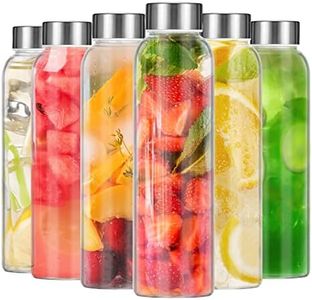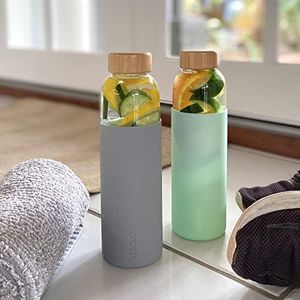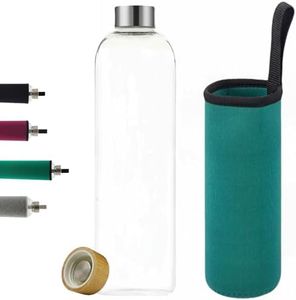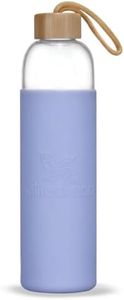We Use CookiesWe use cookies to enhance the security, performance,
functionality and for analytical and promotional activities. By continuing to browse this site you
are agreeing to our privacy policy
10 Best Glass Water Bottles
From leading brands and best sellers available on the web.By clicking on a link to a third party's website, log data is shared with that third party.
Buying Guide for the Best Glass Water Bottles
Choosing a glass water bottle is a great step towards healthier hydration and environmentally friendly habits. Unlike plastic, glass does not leach chemicals or alter the taste of your beverage, and it is usually easier to clean. To find the best glass water bottle for your needs, it's important to understand a few key features and how they relate to your daily life, so you end up with a bottle that's convenient, long-lasting, and safe.CapacityCapacity refers to how much liquid the bottle can hold, usually measured in ounces or milliliters. This is important because it affects how heavy the bottle will feel and how often you’ll need to refill it. Small bottles (around 12-16 oz or 350-500 ml) are lightweight and compact, great for short trips or kids. Medium bottles (about 17-25 oz or 500-750 ml) balance portability with enough water for most daily use. Large bottles (over 25 oz or 750 ml) are ideal if you want to minimize refills or use it during long workouts. To pick the best capacity, think about when and where you’ll use your bottle the most—commuters or travelers may prefer lighter, smaller bottles, while athletes or those in hot climates might need more volume.
Mouth OpeningMouth opening is the diameter of the bottle’s opening. A wide mouth makes it easier to fill the bottle, add ice or fruits, and clean it thoroughly. However, wide mouths can sometimes be harder to drink from while moving, and spills are more likely. Narrow mouth bottles are spill-resistant and easier to sip from, but might be tricky to clean or to add ice cubes. Think about your priorities: if you want convenience for adding things or cleaning, a wide mouth is ideal; if you mostly drink on-the-go or want fewer spills, look for a narrow opening.
Protective SleeveMany glass water bottles come with protective sleeves, often made from silicone or rubber. These sleeves cushion against bumps, provide grip, and can insulate the bottle slightly. If you’re worried about breaking your bottle or want some insulation, a bottle with a sturdy sleeve is a smart choice. Some sleeves are removable for cleaning, while others are fixed. If you have an active lifestyle or plan to take the bottle out often, prioritize one with a good sleeve.
Lid TypeThe type of lid controls how you drink from the bottle and how leak-proof it is. Common options include screw-on caps, flip tops, straw lids, and spouts. Screw-on lids are very secure and leak-resistant but slower to open. Flip tops and spout lids are quick and handy for one-handed use. Straw lids can be great for sipping during exercise, but may be harder to clean. Think about where and when you’ll use the bottle—if you'll be tossing it in a bag, focus on leak-proof lids; if you'll be using it while working or commuting, quick-access designs may be better.
Ease of CleaningCleaning is crucial for hygiene, especially when using your bottle daily. Bottles that come apart easily and have wide mouths tend to be easiest to clean. Some are dishwasher-safe, which makes maintenance simple. Others may have tricky corners or special lids that require hand washing. Consider your willingness to clean by hand, or if you prefer to use a dishwasher. If daily cleaning sounds like a hassle, opt for a design noted for easy cleaning.
Glass Thickness and WeightThe thickness of the glass affects the durability and weight of the bottle. Thicker glass may survive more bumps but will be heavier, while thinner glass is lighter but might break more easily. If you plan to carry your bottle far or often, lightweight options may feel more comfortable. If it will mostly stay on your desk or in your car, a thicker, heavier bottle may be fine and more robust.















